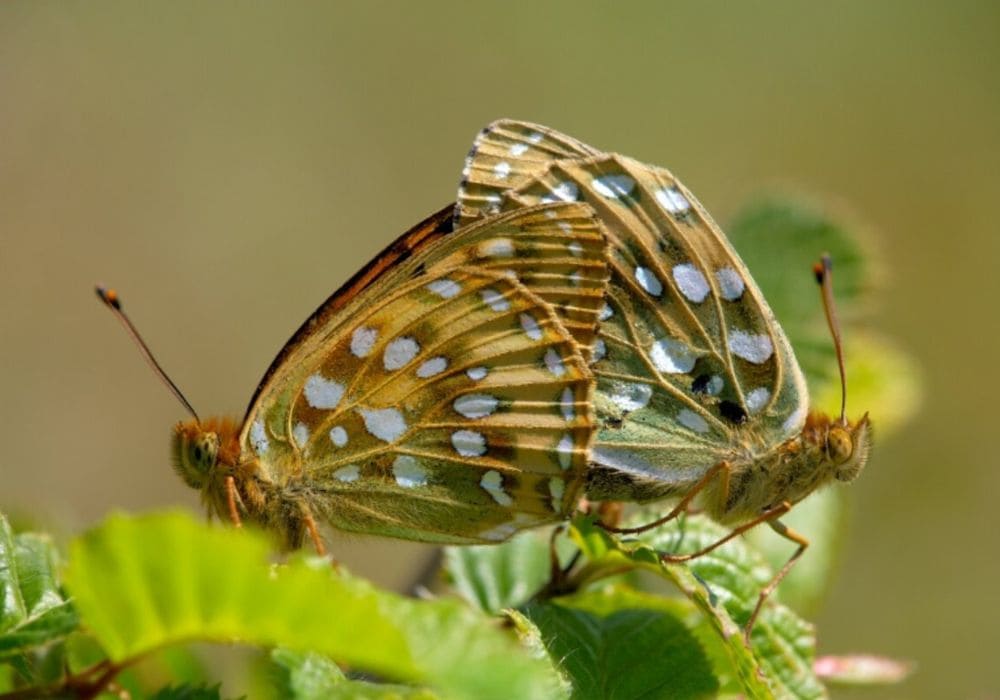Butterflies are insects of the order Lepidoptera, which also includes moths. When resting, butterflies fold their wings vertically above their heads, while moths hold them horizontally.
Most butterflies are active during the day, while moths are mostly nocturnal. During their life, butterflies undergo a complete metamorphosis, that is, the egg hatches into a larva (or caterpillar), which transforms into a chrysalis, from which the adult butterfly (or imago) emerges.
These insects have been present on Earth for more than 300 million years and are today essential to the survival of eco-systems. Their beauty and grace are a true inspiration for jewelers. If you are sensitive to these magnificent creatures, perhaps you will find what you are looking for among our butterfly necklaces.
The evolution of butterflies
Butterflies probably began evolving around 150 million years ago, appearing around the same time as flowering plants (or angiosperms). Of the 220,000 species of Lepidoptera, about 45,000 are butterflies, which probably evolved from moths. Butterflies are found everywhere in the world except Antarctica, and are particularly numerous in the tropics.
They are divided into eight families:
- Papilionidae
- Pieridae
- Danaidae
- Satyridae
- Morphidae
- Nymphalidae
- Lycaenidae
- Hesperidae
Development and life cycle
The adult life of butterflies lasts only a week for some species, but up to 11 months for others.
Adult butterflies spend most of their time courting, mating, and (for females) laying eggs. Females lay eggs on the specific food plant the caterpillar needs to feed on.
Eggs are usually laid on leaves, flowers or stems, but sometimes on tree bark or even stones, leaving the newly hatched caterpillars to find the plant they need. A few species of butterflies lay their eggs in flight, with the eggs attaching to food plants as they fall.
The egg

When most female butterflies emerge from the chrysalis, their eggs are fully mature, allowing immediate fertilization. Tiny pores in the egg allow entry of male sperm for fertilization. Eggs can be laid singly, in rows, in clusters, or in rings around a plant stem.
The eggs are very vulnerable to predators and parasites. Females lay up to 600 eggs at a time. A sticky substance produced during egg laying sticks them to the host plant. Most hatch within a few days, but some species remain dormant over winter and hatch in spring.
Caterpillar

The larval stage of butterflies, called a caterpillar, emerges from the egg fully formed. Caterpillars see through groups of small eyes located on each side of their head. The body of many species is protected by bristling hairs. Caterpillars have up to eight pairs of appendages. Three pairs are true legs, which will become the legs of the adult butterfly. They are located on the thorax, behind the head. Four more pairs of appendages are found on the abdomen and are called prolegs or prolegs.
There is also a single pair of pincers at the end of the abdomen, which cling tightly to the food plant. The prominent legs and pincers also bear tiny hooks that catch a silk thread woven by the larva as it moves around its food plant and prevent it from falling. Silk thread is produced as a thick liquid, excreted from glands near the mouth, which is then spun into a thread by a spinneret behind the jaws.
Caterpillars spend most of their time eating. Their large jaws (mandibles) move sideways while shredding their plant food. Caterpillars snack throughout their lives: they first eat the shell of their egg, from which they obtain important nutrients, and then continually consume the plants on which they feed.
A small number of butterfly species have caterpillars that are predators that feed on other insects. Caterpillars typically eat more than twice their own weight each day, stopping only to shed their old skin in order to grow. Shedding of the skin (molting or ecdysis) occurs at least four times before the caterpillar is fully adult.
Growth rate depends on temperature; it is faster in hot weather, and slower in cool weather. The caterpillars seek a protected place to pupate, forming a protective covering and becoming dormant. Some caterpillars travel quite long distances (100 meters) when looking for a sheltered place to transform into a chrysalis.
The chrysalis

The protective covering that surrounds the pupating caterpillar can take many forms. It is generally brownish green in color, and may be speckled for ease of camouflage. With few exceptions, butterfly larvae pupate above ground, usually attached to a leaf or stem by a silk thread.
Inside the chrysalis, the caterpillar gradually transforms into a butterfly. This process takes two weeks for some species, and several years for others. When fully developed, the butterfly inside the chrysalis swallows air, inflating its body and splitting the pupa's skin.
An adult butterfly emerges shortly after dawn, its wet wings hanging limply from its thorax. Crawling to a place where it can hang by its legs, the new butterfly inflates its wings by swallowing air, increasing its internal pressure and forcing blood through the tiny veins in the wings. Within a few hours, the outstretched wings dry and harden. Around the same time, the butterfly excretes waste accumulated during pupation. The butterfly is now free to begin the adult part of its life cycle.
The adult (or imago)

Butterflies, like all insects, have an external skeleton (or exoskeleton) to which muscles are attached. The exoskeleton serves as support for the butterfly's body and reduces water loss through evaporation. The respiratory system does not have a pumping mechanism.
The sides of the thorax and abdomen have tiny pores (or spiracles) through which air enters and leaves the body through tubes (tracheas). The insect's blood (hemolymph) is pumped as it passes through a long, thin heart, and bathes the organs inside the body cavity.
Two large compound eyes, made up of hundreds of tiny units (ommatidia), cover much of the butterfly's head and allow a wide field of vision, including partially backwards. However, the eyes cannot distinguish many details or determine distance, but they can easily identify colors and movement, both of which are essential for survival. Colors help identify flowers, larval food plants, and the opposite sex of the species, while motion detection can save butterflies from attacks by predators .
The butterfly's long, curled proboscis (tongue) is projected into the center of flowers when it searches for nectar (a liquid food rich in sugar). Above the eyes and on either side of the head are two antennae covered with microscopic sensory organs.
The antennae are often wrongly called "feelers", but "scenters" would be more accurate, because it is through these organs that the butterfly sniffs its favorite foods and its potential partner. Antennae can detect pheromones, which are specific chemical signals given off by the opposite sex and detectable over a great distance.
A butterfly's thorax is divided into three segments, each with a pair of legs. Each leg ends in a claw, which allows the butterfly to hold itself while it feeds and lays its eggs. Sensory receptors located on the paw just above the claw detect the chemical composition of suitable food plants.
The wings are the most spectacular part of the butterfly, and are extremely large in relation to its body. The wings attach to the two rear segments of the thorax. Strong ribs form a structure that supports the wing membrane, covered with millions of microscopic scales arranged in rows like shingles on a roof. It is these scales (about 15,000 per cm²) that form the color and pattern of the wing.
Brown, orange and black tones are due to the presence of chemical pigments. However, the bright, iridescent blues and greens are parts of the light spectrum separated by tiny facets on the surface of the scales, creating colors in a prism-like manner.
Wing colors serve as camouflage against predators and help identify mates of the correct species. The scales also cover the segmented abdomen, in which the digestive and reproductive organs are located.
Reproduction

Reproduction in butterflies begins with courtship, during which the male flaps his wings vigorously, releasing a dust of microscopic pheromone-carrying scales above the female's antennae. These male pheromones act as a sexual stimulant for the female. Some males release additional pheromones from "hair pencils" located under the abdomen.
Female butterflies that are ready to mate do not court. However, some species perform complicated maneuvers, probably to find a mate strong enough to endure the rigorous rituals, thereby increasing the chances of producing healthy offspring. Males usually have to wait a day or two after emerging from the chrysalis before they can mate, but they may then do so several times.
Females may mate immediately after emergence, with some species mating multiple times. However, it is the last male to mate who fertilizes the eggs. Females of some species mate only once.
Migration

Most butterfly species live and die in a narrow geographic area because their short lifespans leave them little time to move. However, the monarch butterfly migrates thousands of miles from southern Canada and the northern United States to Mexico and coastal southern California.
The round trip takes two or three generations, due to the short lifespan of individuals. Each butterfly must find its own path, having no living guide, but the species follows the same great migratory route year after year, century after century.
Monarchs and some other butterflies migrate in large numbers, forming clouds of color that are sometimes a kilometer wide and a kilometer long; millions of butterflies perish during the journey.
Vulnerability and defense

The survival of butterflies is influenced by many factors, and their populations can increase or decrease quite quickly, and from year to year. The brightly colored butterflies are often toxic when eaten, so predators learn to leave them alone. Sometimes a non-toxic species evolves and mimics the appearance of a toxic species, making it less vulnerable to predators.
The dark colors, sported by butterflies in cooler climates (such as alpine or arctic tundra), readily absorb sunlight so the cold-blooded insect can warm up more quickly.
Some butterflies are well camouflaged and almost undetectable among the flowers of the plant on which they feed. Various eye-like spots on the outer edge of the wings of some species can frighten or distract predators, moving the point of attack of a swooping bird away from the soft body of the butterfly.
Some butterflies make a 180-degree turn before landing, so the eyespots on the wings are positioned where a predator might think the head should be. Butterflies that survive bird attacks can often fly well even if they are missing a piece of their wing.
The underside of the wing is usually duller than the surface, so that when the butterfly assumes its resting position, with its wings folded overhead, it is a mysterious color, blending into the background on which it lands. Some butterflies use the club at the end of their antennae to knock down small predators.
The hairy spines of many caterpillars deter predators, and their colors often blend with those of the leaves of their food plant. Some pupae develop horn-like appendages on the head and rear of the pupa, which appear to point menacingly toward predators. In other cases, a chrysalis clinging to a twig may resemble a dead leaf.
Conservation

Habitat loss from agriculture, deforestation, urbanization, drying of wetlands, and other land use changes poses the primary threat to butterfly populations. Although pollution, pesticides, and specimen collecting pose serious threats to some species, none are as damaging as habitat loss.
Due to the short lifespan of butterflies, it is generally impossible for displaced populations to find suitable alternative habitat. Although no species has been made extinct by human action, some subspecies have become extinct and some rare species are endangered. Habitat protection is the most effective way to prevent significant population reductions and endangerment of butterflies, as well as other wild animals and plants.






Dayana
Bonjour Barbey,
Oui, les papillons peuvent suivre des circuits réguliers et revenir au même endroit chaque année, attirés par des conditions environnementales favorables telles que la lumière, la température, ou la disponibilité de nourriture.
Barbey
Bonjour ,tous les ans 15/06 au15/07 ils viennent entre 18h30/a19h30 sur une table blanche dans ma pelouse …question les papillons ont ils un circuit journalier …comme les oiseaux viennent ils au même endroit tous les ans …pour moi OUI…mais j aimerai une confirmation ??merci J Barbey